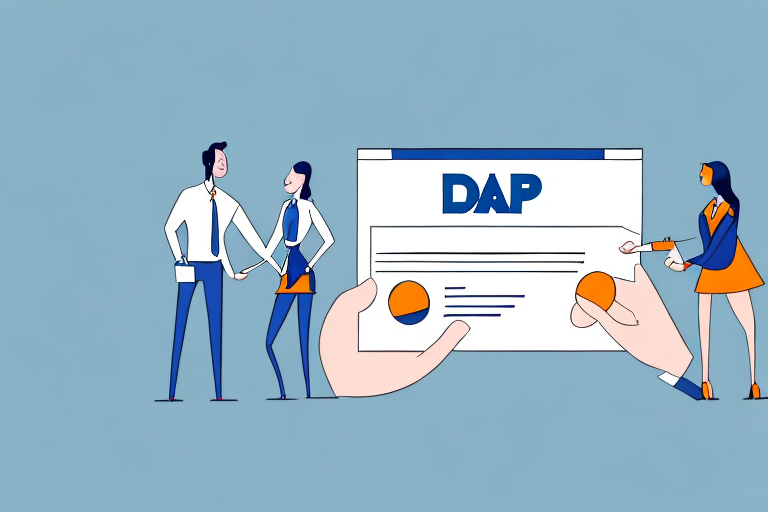Understanding DAP Payment Terms in International Business Transactions
In the realm of international trade, payment terms play a pivotal role in defining the responsibilities and obligations of both buyers and sellers. One such widely used term is Delivered at Place (DAP). This article delves into the intricacies of DAP payment terms, exploring how they function, their benefits and risks, and best practices for their implementation. Additionally, we will compare DAP with other international shipping terms, provide case studies, and offer strategies for effective cash flow management and risk mitigation.
What is DAP Payment Term?
Delivered at Place (DAP) is an Incoterm® published by the International Chamber of Commerce (ICC), which specifies that the seller delivers goods to a named destination. Under DAP, the seller assumes all risks and costs associated with delivering the goods to the specified location, excluding import duties and taxes, which are the buyer's responsibility.
For instance, if a seller in Germany agrees to deliver goods to a buyer in Brazil under DAP terms, the seller handles all transportation, export clearance, and delivery to the agreed-upon place in Brazil. However, the buyer must manage the import clearance and pay any applicable duties and taxes.
For more detailed information on Incoterms, refer to the official ICC guidelines here.
Benefits of Using DAP Payment Terms
Opting for DAP payment terms offers several advantages to both buyers and sellers:
- Reduced Burden on Buyers: Buyers do not need to manage the transportation logistics, as the seller handles delivery to the specified location.
- Market Expansion for Sellers: Sellers can access new international markets by offering comprehensive delivery services.
- Clear Responsibilities: DAP clearly delineates the responsibilities of each party, minimizing misunderstandings.
- Flexibility: The named destination can be tailored to meet the specific needs of the buyer.
According to a Statista report, global trade volume reached approximately $25 trillion in 2022, underscoring the importance of efficient payment terms like DAP in facilitating international commerce.
How DAP Payment Terms Operate
Under DAP terms, the seller is responsible for:
- Arranging and paying for transportation to the agreed destination.
- Handling export customs clearance and any associated costs.
- Providing necessary shipping documentation.
The buyer is responsible for:
- Import customs clearance and payment of duties and taxes.
- Arranging for unloading and any further transportation beyond the agreed destination.
It's crucial for both parties to clearly define the exact location of delivery to avoid disputes. Utilizing reputable logistics providers and maintaining open communication can enhance the efficiency of DAP transactions.
Comparing DAP with Other International Shipping Terms
Understanding how DAP differs from other Incoterms® is essential for making informed decisions:
| Incoterm | Seller's Responsibility | Buyer's Responsibility |
|---|---|---|
| EXW (Ex Works) | Offers goods at their premises. | Handles all transportation and risks from the seller's location. |
| FOB (Free On Board) | Responsible until goods are loaded on the shipping vessel. | Manages all costs and risks post-loading. |
| CIF (Cost, Insurance, and Freight) | Pays for transportation and insurance to the destination port. | Handles import duties and inland transportation. |
| DDP (Delivered Duty Paid) | Assumes full responsibility, including import duties and taxes. | Receives goods at the specified destination. |
| DAP (Delivered at Place) | Responsible for all costs and risks up to the named place. | Handles import clearance and related costs. |
This comparison highlights DAP's balance of responsibilities, making it a flexible option for many international transactions.
Risks and Mitigation Strategies in DAP Transactions
While DAP offers numerous benefits, it also comes with inherent risks that businesses must address:
Potential Risks
- Customs Delays: Delays in customs clearance can disrupt the supply chain.
- Unexpected Costs: Buyers may face unforeseen import duties or taxes.
- Damage During Transit: Although the seller manages transportation, goods can still incur damage before delivery.
Mitigation Strategies
- Comprehensive Insurance: Utilize cargo insurance to protect against potential damages.
- Clear Documentation: Ensure all shipping documents are accurate and complete to facilitate smooth customs clearance.
- Reliable Logistics Partners: Partner with reputable logistics providers to minimize the risk of delays and mishandling.
Implementing these strategies can significantly reduce the risks associated with DAP transactions.
Best Practices for Implementing DAP Payment Terms
To ensure the success of DAP transactions, businesses should adhere to the following best practices:
Detailed Contract Agreements
Clearly outline the responsibilities of both parties, including the exact delivery location, in the contract to avoid ambiguities.
Effective Communication
Maintain regular communication with suppliers and logistics providers to stay informed about the shipment’s status and address any issues promptly.
Accurate Documentation
Ensure all necessary documents, such as commercial invoices, packing lists, and bills of lading, are accurate and readily available to expedite customs clearance.
Reliable Logistics Providers
Choose logistics partners with a proven track record in handling international shipments to ensure timely and safe delivery of goods.
Financial Planning
Align payment schedules with cash flow projections to ensure funds are available when needed, and consider using financial instruments like letters of credit to secure transactions.
Case Study: Successful Implementation of DAP Payment Terms
Consider the example of ABC Manufacturing, a company based in Germany that exports machinery parts to various countries. By adopting DAP payment terms, ABC Manufacturing took responsibility for delivering goods directly to their clients' facilities in the United States. This approach streamlined the delivery process, reduced the clients' logistical burdens, and enhanced customer satisfaction. As a result, ABC Manufacturing saw a 15% increase in repeat orders within the first year of implementing DAP terms.
Managing Cash Flow with DAP Payment Terms
Effective cash flow management is vital when dealing with DAP terms. Here are some strategies:
- Payment Scheduling: Negotiate payment schedules that align with your business’s cash flow cycles.
- Tracking Systems: Implement systems to monitor payments and delivery statuses in real-time.
- Secure Payment Methods: Use reliable payment systems, such as letters of credit or escrow services, to ensure secure transactions.
- Contingency Planning: Prepare for potential delays or additional costs by maintaining a financial buffer.
Proper cash flow management ensures that businesses can meet their financial obligations without interruption.
Mitigating Risks in DAP Transactions: Insurance and Beyond
To safeguard against the risks inherent in DAP transactions, businesses should employ a combination of insurance and strategic practices:
Insurance Solutions
- Cargo Insurance: Protects against loss or damage during transit.
- Marine Insurance: Covers goods transported over water, providing an additional layer of protection.
Strategic Practices
- Vendor Vetting: Conduct thorough due diligence on suppliers and logistics providers to ensure reliability.
- Regular Audits: Periodically review and assess the effectiveness of your logistics and payment term strategies.
- Training: Educate your team on the nuances of DAP terms and risk management techniques.
Choosing the Right Logistics Provider for DAP Shipping
Selecting a competent logistics partner is crucial for the seamless execution of DAP terms. Consider the following factors:
- Experience and Reputation: Opt for providers with a proven track record in international shipping.
- Customs Clearance Expertise: Ensure the provider is well-versed in the customs regulations of the destination country.
- Comprehensive Services: Look for providers that offer end-to-end services, including transportation, warehousing, and distribution.
- Technological Capabilities: Providers with advanced tracking and communication systems can offer better visibility and control over shipments.
- Insurance Coverage: Verify that the logistics provider offers adequate insurance options to protect your goods.
Partnering with the right logistics provider can significantly enhance the efficiency and reliability of your DAP transactions.
Preparing for Customs Clearance in DAP Transactions
Customs clearance is a critical step in DAP transactions. Proper preparation can prevent delays and additional costs:
- Accurate Documentation: Ensure all necessary documents, such as commercial invoices, packing lists, and certificates of origin, are accurate and complete.
- Regulatory Compliance: Stay informed about the destination country's import regulations and compliance requirements.
- Pre-Clearance Planning: Coordinate with your logistics provider to facilitate timely customs clearance.
- Engage a Customs Broker: Consider hiring a professional customs broker to navigate complex clearance procedures.
Effective preparation for customs clearance ensures a smoother and more predictable delivery process.
Conclusion: Weighing the Benefits and Risks of DAP Payment Terms
Delivered at Place (DAP) payment terms offer a balanced approach to international shipping, providing benefits such as reduced logistical burdens for buyers and expanded market access for sellers. However, businesses must be mindful of the associated risks, including potential delays in customs clearance and unexpected costs. By implementing best practices, choosing reliable partners, and employing effective risk mitigation strategies, companies can leverage DAP terms to enhance their international operations and build stronger business relationships.
For further reading on Incoterms and international trade best practices, visit the International Chamber of Commerce.






















